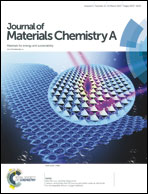Pyrite FeS2 microspheres anchoring on reduced graphene oxide aerogel as an enhanced electrode material for sodium-ion batteries†
Abstract
Pyrite, FeS2, is a promising sodium battery electrode candidate owing to its abundance in natural resources; however, it suffers from poor cyclic performance and poor rate performance, which hinders its large-scale commercial application. The semiconductor nature of pyrite as well as the dissolution of polysulfide and the destruction of the morphology of pyrite during the charge/discharge process are the main reasons for the abovementioned two drawbacks. In this study, a well-designed FeS2/rGO-A composite was constructed using an ambient temperature reaction. The introduction of rGO-A improved the conductivity of the entire material without hindering sodium ion diffusion; it also confined the pulverized active material to prevent its loss. Additionally, by controlling the cutoff voltage above 0.8 V, the formation of polysulfide was avoided. As a result, the FeS2/rGO-A electrode displays both excellent cyclic performance (low decay rate of 0.051% per cycle over 800 cycles at 1C) and rate performance (more than 70% discharge capacity is retained at 5C compared to 0.1C). The unique electrochemical mechanism was also investigated in detail. A new perspective of pyrite electrochemical behavior was obtained. This study provides not only a theoretical basis for further study, but may also enable the large-scale commercial application of sodium-ion batteries.



 Please wait while we load your content...
Please wait while we load your content...